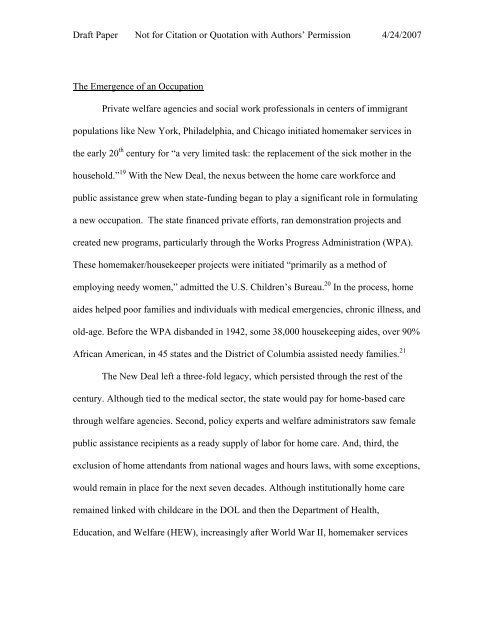Organizing Home Care: - School of Social Service Administration
Organizing Home Care: - School of Social Service Administration
Organizing Home Care: - School of Social Service Administration
You also want an ePaper? Increase the reach of your titles
YUMPU automatically turns print PDFs into web optimized ePapers that Google loves.
Draft Paper Not for Citation or Quotation with Authors’ Permission 4/24/2007<br />
The Emergence <strong>of</strong> an Occupation<br />
Private welfare agencies and social work pr<strong>of</strong>essionals in centers <strong>of</strong> immigrant<br />
populations like New York, Philadelphia, and Chicago initiated homemaker services in<br />
the early 20 th century for “a very limited task: the replacement <strong>of</strong> the sick mother in the<br />
household.” 19 With the New Deal, the nexus between the home care workforce and<br />
public assistance grew when state-funding began to play a significant role in formulating<br />
a new occupation. The state financed private efforts, ran demonstration projects and<br />
created new programs, particularly through the Works Progress <strong>Administration</strong> (WPA).<br />
These homemaker/housekeeper projects were initiated “primarily as a method <strong>of</strong><br />
employing needy women,” admitted the U.S. Children’s Bureau. 20 In the process, home<br />
aides helped poor families and individuals with medical emergencies, chronic illness, and<br />
old-age. Before the WPA disbanded in 1942, some 38,000 housekeeping aides, over 90%<br />
African American, in 45 states and the District <strong>of</strong> Columbia assisted needy families. 21<br />
The New Deal left a three-fold legacy, which persisted through the rest <strong>of</strong> the<br />
century. Although tied to the medical sector, the state would pay for home-based care<br />
through welfare agencies. Second, policy experts and welfare administrators saw female<br />
public assistance recipients as a ready supply <strong>of</strong> labor for home care. And, third, the<br />
exclusion <strong>of</strong> home attendants from national wages and hours laws, with some exceptions,<br />
would remain in place for the next seven decades. Although institutionally home care<br />
remained linked with childcare in the DOL and then the Department <strong>of</strong> Health,<br />
Education, and Welfare (HEW), increasingly after World War II, homemaker services
















